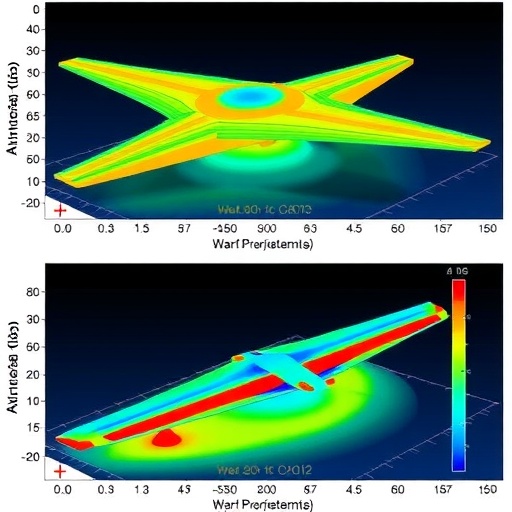In the evolving landscape of aerospace engineering, high-altitude long-endurance (HALE) aircraft stand out as pinnacles of aerodynamic innovation and operational longevity. Designed to operate at stratospheric altitudes for extended periods, these aircraft present unique challenges that are increasingly the focus of cutting-edge research. Their remarkable aerodynamic efficiency and prolonged dwell times, pivotal for applications such as surveillance, scientific observation, and communications, also expose them to complex nonlinear aerodynamic and structural phenomena. These coupled nonlinearities evoke aeroelastic responses that diverge markedly from those observed in systems characterized by isolated nonlinear effects, raising significant concerns for structural integrity and flight safety.
Historically, the study of aeroelastic responses in aircraft has concentrated primarily on systems exhibiting either structural or aerodynamic nonlinearity independently. Structural nonlinearity often arises from material properties and geometric configurations that deviate from linear elasticity under high loads, causing nonlinear deformation behaviors. Aerodynamic nonlinearity, conversely, emerges through phenomena like flow separation, vortex shedding, and dynamic stall, which alter the aerodynamic forces beyond linear assumptions. While these individual nonlinearities have been studied extensively, their interaction within HALE aircraft operating in severe atmospheric conditions is less understood, leaving a critical gap in predictive modeling and risk assessment.
This research void is particularly pressing considering the unique operational envelope of HALE platforms. Operating at altitudes where air density is low, and temperatures are harsh, these aircraft experience aeroelastic phenomena that differ substantially from those seen at lower altitudes. The structural dynamics of their slender, flexible wings can interact with nonlinear aerodynamic forces in unexpected ways, potentially leading to resonance, limit cycle oscillations, or even catastrophic structural failure. Such outcomes underscore the necessity of developing models that integrate both nonlinear structural and aerodynamic effects to capture the authentic aeroelastic behavior.
Coupled nonlinearities in aeroelastic systems introduce complexities far exceeding the sum of their individual effects. When structural flexibility interacts with nonlinear aerodynamic loading, it can give rise to phenomena such as bifurcations, where small parameter changes cause sudden qualitative shifts in response. This includes jump phenomena, hysteresis, and multiple equilibrium states, complicating control strategies and structural health monitoring. The nonlinear dynamic responses become particularly challenging to predict, necessitating advanced computational tools and experimental validation to ensure robustness in design and operation.
Emerging computational methodologies have begun to address these challenges, employing high-fidelity fluid-structure interaction simulations that account for the nonlinear coupling between aerodynamic forces and structural deformations. These models incorporate material nonlinearities, geometric nonlinearities like large deformations, and sophisticated aerodynamic theories that consider flow separation and unsteady vortices. However, computational expense and model complexity limit their widespread application, stimulating research into reduced-order models that retain essential nonlinear characteristics while being computationally tractable.
Another frontier lies in experimental aeroelastic testing under realistic environmental conditions. Wind tunnel experiments, while invaluable, often struggle to replicate the low-density, high-altitude atmosphere and the associated unsteady aerodynamic effects accurately. Flight testing with instrumented prototypes provides vital data, yet risks and costs constrain the breadth of such campaigns. Advances in sensor technologies, real-time data analytics, and adaptive control mechanisms promise to enhance experimental capabilities and in-flight monitoring, enabling better characterization and mitigation of nonlinear aeroelastic phenomena.
The influence of coupled nonlinearities extends beyond structural integrity concerns to affect flight dynamics and control. Aeroelastic instabilities may propagate into the flight control system, triggering oscillations or degraded handling qualities that challenge pilot or autonomous systems. Designing control laws that account for these nonlinear effects necessitates interdisciplinary approaches combining aeroelasticity, control theory, and real-time system identification. This integrative perspective is crucial to advancing HALE aircraft readiness and ensuring mission success under a wide range of atmospheric disturbances.
Beyond safety and performance, understanding these nonlinear aeroelastic interactions informs innovative design paradigms. With accurate predictive models, engineers can exploit nonlinear phenomena to achieve adaptive morphing structures and flow control techniques that enhance aerodynamic efficiency and resilience. For instance, controlled aeroelastic deformation may enable wings that adjust shape dynamically in response to changing flight conditions, optimizing lift-to-drag ratios and extending operational endurance, revolutionizing future HALE platforms.
The implications of coupled nonlinear aeroelasticity also reach into regulatory and certification frameworks. Demonstrating compliance with stringent safety margins requires validated models that reliably predict nonlinear responses across operational envelopes. Regulatory bodies are increasingly recognizing the need for standards and protocols addressing complex aeroelastic behaviors, prompting collaborations between researchers, manufacturers, and policy-makers. Clear guidelines will foster innovation while ensuring the structural reliability and operational safety of next-generation HALE aircraft.
Interdisciplinary research efforts blending aerospace engineering, materials science, applied mathematics, and computational fluid dynamics are accelerating progress in this domain. Nonlinear dynamics, bifurcation theory, and chaos analysis provide conceptual frameworks that elucidate complex aeroelastic phenomena, guiding model development and interpretation. Integration of machine learning techniques shows promise in identifying patterns and predicting nonlinear aeroelastic responses from experimental and simulated datasets, offering novel pathways for real-time system diagnostics and adaptive control implementation.
The strategic importance of HALE aircraft in both civilian and military contexts intensifies the urgency of resolving these research challenges. Whether supporting global telecommunications, environmental monitoring, or reconnaissance, the reliability and performance of these platforms hinge on a thorough understanding of their aeroelastic characteristics. Addressing the coupled nonlinear aeroelastic problem is not merely an academic pursuit but a critical step toward unlocking the full potential of HALE systems in the coming decades.
In conclusion, the investigation of coupled aerodynamic and structural nonlinearities represents a frontier in aeroelastic research with significant implications for the design, operation, and safety of high-altitude long-endurance aircraft. Bridging this knowledge gap demands multi-faceted research approaches integrating theoretical, computational, and experimental methods. As the aerospace community intensifies focus on these complex interactions, the resulting insights will propel the development of HALE platforms capable of unprecedented endurance and reliability, fundamentally transforming high-altitude aviation.
Subject of Research: Aeroelastic nonlinearities in high-altitude long-endurance aircraft
Article Title: Understanding Coupled Nonlinear Aeroelastic Phenomena in High-Altitude Long-Endurance Aircraft
Image Credits: EurekaAlert.org




